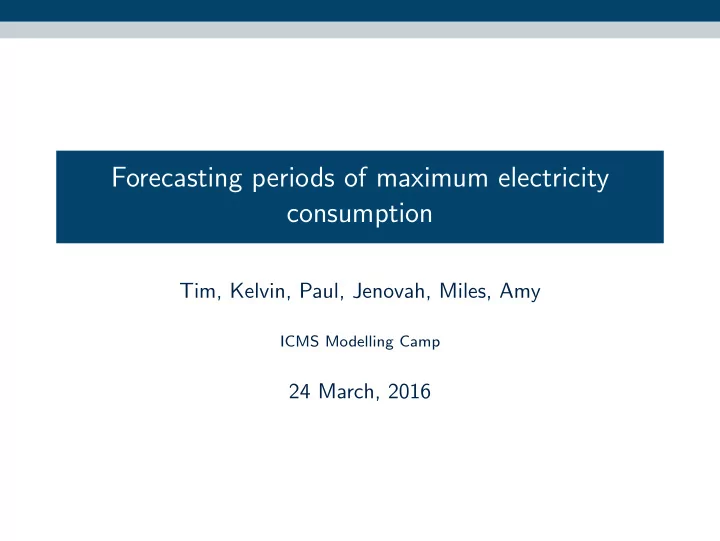

Forecasting periods of maximum electricity consumption Tim, Kelvin, Paul, Jenovah, Miles, Amy ICMS Modelling Camp 24 March, 2016
Introduction Reduce energy consumption during peak times in the winter period. Add a surcharge to the three half-hour periods of highest energy consumption. These ‘Triads’ must be spaced by at least 10 days. Figure: www2.nationalgrid.com
Dissecting the Problem We want to correctly identify the three triads, with a small number of warnings. Capture three minima in the system. Use forecast data in our method. Include historical data. The triads have to be spaced by at least 10 days.
Assumptions Discount weekends and holidays. Cold weather is the only thing that determines energy consumption. There is no feedback - giving customers a warning won’t change the position of a triad.
Assumptions: Continued
The Secretary Problem A simplification of our problem. We look at the secretary problem. Give one warning and try to give it on the worst day.
Optimal Algorithm Do not choose the first r days. Give a warning on the first day worse than the first r days. n P success ( r ) = 1 r − 1 � i − 1 n i = r +1 It can be shown that for large n , optimal r = n / e , and P success ( n / e ) = 1 / e .
An Extension of the Secretary Problem We now allow k warnings, and want to guess the minimum. We adjust the secretary problem, find r using a numerical method. n P success ( r ) = n − r + 1 ( i − k − 1)!( i − r )! � n n ( i − 1)!( i − k − r )! k ! i = r + k Here k = 3, which gives r = 4, and P success (4) = 0 . 852.
Benefits and Limitations + We can choose how many warnings we want to give. + Easy to implement. + Has a much smaller rejection region − How good it is for three minima? − The distributions are i.i.d. − It doesn’t account for historical data.
An Alternative Method We assume we know the distribution that the weather takes. We find a threshold value C , if the temperature is lower than C , assign a warning.
Benefits and Limitations + Easy to implement. + Choose accepted accuracy. + Take into account historical data. + Captures 3 minima. − Historical data is all over the place! − We haven’t included forecasting, or spacing between triads.
Historical Data
Including Forecasting We assume we have an accurate forecast for today and tomorrow. On day k , if day k + 1 is forecast to be worse, we don’t assign a warning to day k , UNLESS day k is a Thursday! We also use previous data from the same week.
An Example of the Algorithm
Applying the Algorithm N.B. NPower issue an average of 17 warnings per year. Naive threshold temperature: average 9.7 warnings issued Derived threshold temperature: average 10.1 warnings issued
Conclusions We’ve created a mathematically justified algorithm We’ve used less warnings then N-Power However: What about the triad spacing? What about uncertainty in forecasting? Do warnings produce negative feedback?
Thanks for listening!
Recommend
More recommend